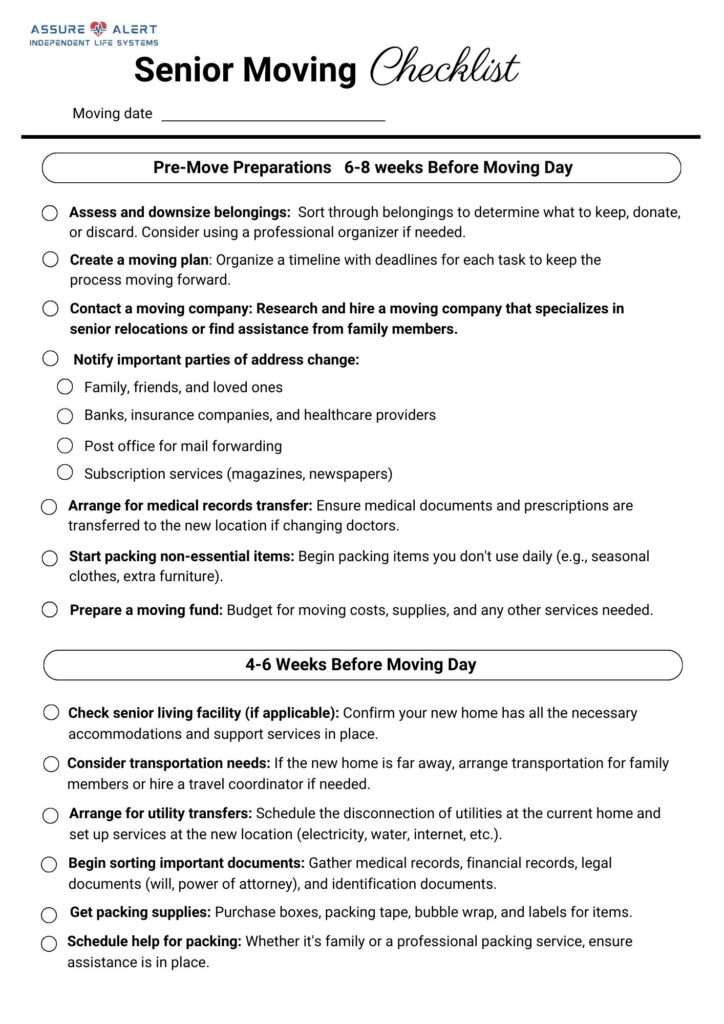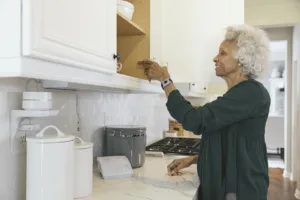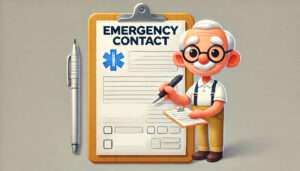Introduction
Senior moving is a significant life event that requires thoughtful preparation and care. For many older adults, relocating involves not only physical labor but also emotional and logistical challenges. From downsizing long-cherished belongings to coordinating with family members and professional movers, the journey can be overwhelming. That’s why using a detailed senior moving checklist can help seniors stay organized and reduce stress while ensuring that nothing is overlooked.
By leveraging senior moving help from professional services and family support, the process can be smoother and more manageable. In this guide, we’ll outline essential steps to simplify senior moving and make the transition as comfortable as possible.
Pre-Move Preparation: 6-8 Weeks Before Moving Day
Assess and Downsize Belongings
Downsizing is one of the most critical tasks when planning a senior move. It’s best to start the process early to avoid rushing through decisions. Sorting through years of possessions can be emotional, so consider enlisting the help of a professional organizer with experience in senior moving assistance.
Encourage seniors to keep essential and sentimental items while donating or discarding items they no longer need. For a comprehensive guide to this process, download our senior moving checklist to ensure nothing is overlooked.
Notify Important Parties of Address Change
Update your address with critical organizations and services well in advance of the move. Notify the post office, financial institutions, subscription services, and utility companies. This ensures uninterrupted access to essential services, which can make settling into the new home easier.
Maintaining good communication with these organizations is a key part of a senior moving checklist, as it prevents overlooked services from causing issues later.
Hiring a Moving Company
Hiring the right movers can make all the difference in a senior relocation. Many companies specialize in senior moving services, offering tailored assistance like packing, unpacking, and transporting fragile belongings with extra care.
To find local movers in your area, use a Google search for “senior moving companies near me”. Check reviews and verify their experience in working with senior clients before making a decision.
Mid-Stage Moving Tasks: 4-6 Weeks Before Moving Day
Check the New Home
If moving to a senior living facility or downsized home, schedule a visit to inspect the space and confirm it meets all needs. Make sure doorways are wide enough for mobility aids and that safety features like grab bars are installed if necessary.
For a step-by-step guide on preparing your new home, consult our senior moving checklist.
Arrange for Utility Transfers and Transportation
Contact utility providers to transfer or activate services at the new address. Set up services like water, electricity, internet, and phone lines to be operational before moving day.
For transportation, seniors who no longer drive should arrange reliable options for travel within their new community, whether it’s public transportation, ride-sharing services, or scheduled transport from family members.
Start Packing Non-Essential Items
Begin by packing items that are rarely used, such as seasonal decorations, extra linens, and stored memorabilia. Clearly label each box with its contents and the room it belongs to, which is a crucial step in any senior moving checklist. This makes unpacking easier and more efficient.
Final Weeks Before Moving Day: 1-2 Weeks Before
Contact Healthcare Providers
Ensure that healthcare providers are informed of the upcoming move and request that medical records be transferred to the new provider if necessary. Seniors should also verify that they have enough prescription medications to cover the moving period.
Good health management during senior moving is vital, and staying connected with healthcare providers ensures continuity of care.
Coordinate with Movers
Confirm all moving arrangements with the chosen moving company, including the date, time, and special instructions for handling fragile or high-value items. Clear communication minimizes confusion on moving day.
To compare local movers, try this Google search for “best senior movers near me”.
Label and Pack Items
For effective senior moving assistance, ensure that each box is labeled with the specific room and contents. Consider color-coding labels for additional clarity, as this makes unpacking easier.
Prepare the Home for Moving Day
Pack an “essentials box” with important items like toiletries, medications, snacks, and a change of clothes. This box should be easily accessible and kept separate from other moving boxes to ensure convenience on moving day.
Moving Day: The Big Day
Confirm with Movers and Oversee the Move
Stay in regular communication with the moving team throughout the day. Before leaving the old home, conduct a final walk-through to ensure nothing has been left behind, including items in closets, cabinets, and storage spaces.
Settle into the New Home
Once at the new home, focus on setting up the bedroom first to provide comfort and familiarity. Ensure that other essential spaces like the kitchen and bathroom are also functional.
Professional senior moving assistance services can help with unpacking and organizing, making it easier to adjust to the new space.
Post-Move: The First Week
Unpack Essentials First
Begin by unpacking items from the essentials box and setting up key areas such as the kitchen, bathroom, and bedroom. Gradually unpack the remaining boxes over the week to avoid feeling overwhelmed.
Register with Healthcare Providers
If the move involves relocation to a new city or region, register with local healthcare providers as soon as possible. Verify that insurance and medical services are aligned with the new address.
Introduce Yourself to the Community
Encourage seniors to explore their new surroundings and meet neighbors. Joining community groups, attending events, or participating in activities at a senior center can help foster new social connections and ease the transition.
Conclusion
Senior moving can be challenging, but a well-thought-out moving checklist can simplify the process and reduce stress. From downsizing belongings to coordinating with healthcare providers and hiring the right movers, every step plays a crucial role in creating a smooth transition.
For those seeking professional help, senior moving assistance services provide specialized expertise, making the journey easier for seniors and their families. Download our comprehensive senior moving checklist or consult a Google search for “senior moving companies near me” to help ensure a seamless relocation experience.
Stay Safe During Your Move with Assure Alert
Moving can be a stressful time, but ensuring your safety and peace of mind doesn’t have to be. Whether you’re relocating to a new home or a senior living community, having a reliable medical alert system can provide you with the confidence to navigate this life transition securely.
Assure Alert offers top-of-the-line medical alert systems designed with seniors in mind. With features like fall detection, 24/7 emergency monitoring, and easy-to-use devices, Assure Alert helps you or your loved ones stay protected no matter where life takes you.
Don’t leave safety to chance—visit Assure Alert today to explore how their medical alert systems can give you and your family peace of mind during and after your move.

















